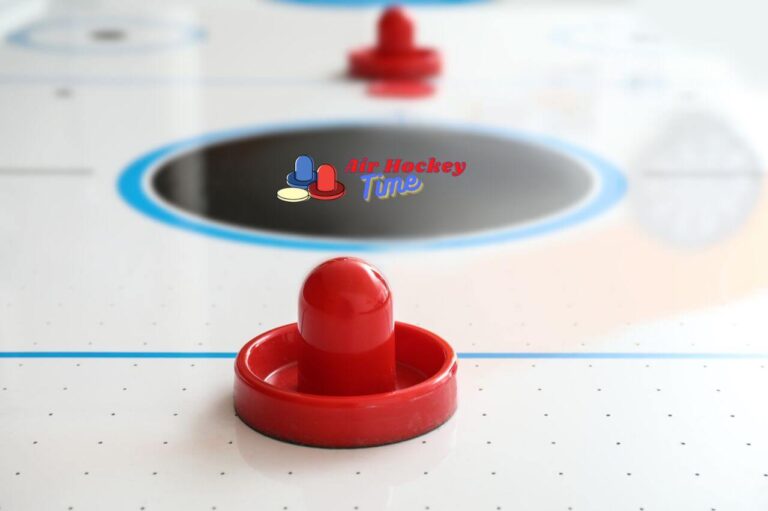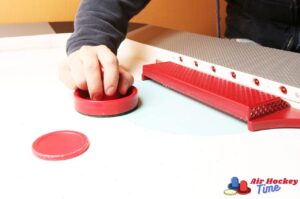As an air hockey enthusiast, you’ve probably heard the phrase, “Keep your mallet close to the goal.” Does that mean we can plant it in front of the goal?
Well, there are both pros and cons to it!
This blog post explores our workflow recommendations and whether 8-14 inches is enough to protect your goal from an attack.
From techniques for holding your mallet firmly in place without penalty infractions—to tips on maximizing effectiveness while playing defense—we have outlined a comprehensive guide that will help you master when and how best to keep your mallet within striking distance (and not too far!).
Whether you’re playing more aggressively or conservatively on the next game night, understanding proper technique now could make a big difference in earning victories later.

What is the Best Way to Position Your Mallet for Maximum Effectiveness?
Air hockey is a fun and exciting game that requires quick reflexes and strategic moves. And when it comes to mastering the game, the position of your mallet plays an important role.
There are a few things to keep in mind to maximize its effectiveness.
First, grip your mallet with your dominant hand comfortably and firmly.
Next, position it slightly in front of your body at a distance of 8-14 inches in front of the goal to give yourself a more comprehensive range of motion and protect the air hockey goal.
And finally, make sure to keep your wrist flexible so you can swiftly move your mallet back and forth, blocking your opponent’s shots and making powerful strikes.
With these tips in mind, you’ll be well on your way to becoming an air hockey pro and quickly dominating the game!
Why Should You Follow the 8-14 Inch Rule for keeping your mallet in Front of the Goal in an air hockey game?
Following the 8-14 inch rule for keeping your mallet in front of the goal in an air hockey game offers several benefits.
Positioning your mallet within this range allows you to maintain a solid defensive stance. With your mallet positioned at this optimal distance, you can effectively block incoming shots and react swiftly to defend your goal.
It gives you enough reach and flexibility to intercept the puck and redirect it away from your goal, decreasing the likelihood of your opponent scoring.
Staying within this range also enhances your ability to anticipate and react to different shot angles and speeds.
It allows for quick transitions between defensive and offensive moves, giving you a tactical advantage in gameplay.
Adhering to the 8-14 inch rule maximizes your defensive capabilities, improves overall gameplay, and increases your chances of air hockey success.
Tips for Making Sure You Keep Your Mallet in Place During Play
Consider implementing a few helpful tips to keep your mallet in place during play and maintain optimal control over the game.
Firstly, maintain a firm grip on your mallet without gripping it too tightly, as excessive tension can limit flexibility and response time.
Position your body in a balanced stance, with your feet shoulder-width apart and your knees slightly bent, to provide stability and mobility.
Keep your eyes focused on the puck and your opponent’s movements to anticipate and react quickly.
Practice proper wrist movements to execute precise shots and defensive maneuvers without losing control of your mallet.
Additionally, be mindful of your body positioning and avoid excessive leaning or reaching, as it can disrupt your balance and compromise your ability to keep the mallet in place.
Regularly practicing and honing your hand-eye coordination will improve mallet control and accuracy.
By applying these tips, you can enhance your performance in air hockey, maintain control over your mallet, and stay fully engaged in the game.
What are the Common Mistakes People Make When Trying To Place Their Mallets Optimally?
When trying to place their mallets optimally in an air hockey game, people often make some common mistakes.
One of the primary errors is gripping the mallet too tightly, which restricts their movement and hinders their ability to react swiftly.
Another mistake is improper body positioning, such as standing too upright or leaning excessively, leading to a lack of balance and compromised control over the mallet.
Additionally, some players focus solely on their mallet and neglect to keep their eyes on the puck and their opponent’s movements, resulting in missed opportunities and vulnerability to counterattacks.
Lack of practice and inadequate wrist movements can also lead to imprecise shots and defensive maneuvers, causing the mallet to be easily dislodged.
Lastly, overreaching or excessive movement can throw off their balance and disrupt their ability to maintain optimal mallet placement.
By being aware of these common mistakes, players can make conscious efforts to avoid them and improve their mallet placement, enhancing their overall performance in air hockey.
Frequently asked questions
Can you stop the puck with the mallet in air hockey?
In air hockey, it is essential to note that stopping or dragging the puck with your mallet is not allowed.
Bringing your mallet down on the puck to stop or control it is known as “topping” and is considered a foul.
Topping the puck is prohibited as it disrupts the game’s flow and goes against the fundamental rules of air hockey.
Instead, players must rely on their reflexes, positioning, and skillful movements to intercept and redirect the puck without directly stopping it with their mallet.
By adhering to this rule, the game remains fair, fast-paced, and accurate to its unique dynamics.
How do you win an air hockey game?
Winning an air hockey game requires a combination of offensive and defensive strategies. While setting up a strong defense is essential, it is just one aspect of achieving victory.
To win, players must also focus on their offensive skills, such as precision shots, quick puck control, and strategic positioning.
Developing a well-rounded game plan that balances defense and offense is critical.
This involves anticipating your opponent’s moves, adapting to changing game dynamics, and capitalizing on scoring opportunities.
Additionally, mastering the art of puck control, agility, and hand-eye coordination can significantly improve your chances of winning.
You can outmaneuver your opponent, score goals, and ultimately secure victory in an exhilarating air hockey match by honing your defensive and offensive abilities.
In conclusion
In conclusion, keeping your mallet in front of the goal in air hockey is a crucial defensive strategy that can significantly impact your gameplay.
Adhering to the 8-14 inch rule for mallet placement offers several advantages, including a practical defensive stance and blocking incoming shots.
By positioning your mallet within this range, you increase your chances of intercepting the puck and redirecting it away from your goal.
It allows for quick reactions to different shot angles and speeds, giving you a tactical advantage. However, maintaining a mallet position requires a firm grip, balanced body positioning, focused eye contact, and proper wrist movements.
By practicing these techniques and avoiding common mistakes, you can enhance your control over the mallet and optimize your defensive capabilities in air hockey.
Ultimately, mastering the art of keeping your mallet in front of the goal contributes to a more vigorous defense and a greater likelihood of success in the game.








